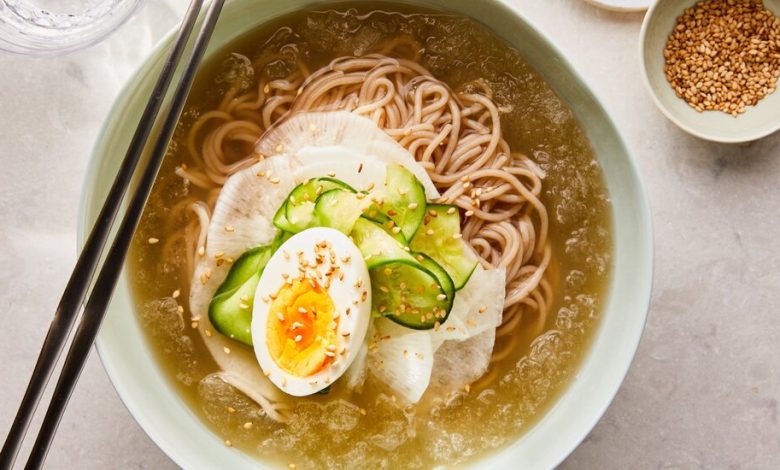You Won’t Just Love These Cold Noodles. You’ll Need Them.

At Olle, the bustling Korean restaurant on East 30th Street in Manhattan, the morning starts with noodle dough. From a mass run through with buckwheat and sweet-potato starch, the noodles are extruded and boiled to order, which is just one of many reasons the naengmyeon at Olle is the best in the city. In less than a second, the doughy tangle drops into a stainless-steel tub of whirling, boiling water. Suddenly animated, the strands swim away like an octopus in flight.
Carefully rinsed, then chilled, each noodle “is so sensitive,” says Yang Ok Kim, Olle’s chef and owner, which is why you shouldn’t cut them when they arrive at your table. The waiter will hold out a pair of kitchen shears: Would you like me to cut your noodles? A test. If you say yes, you fail. When they’re fresh to the table like that, the cold strands are alive, pleasurably chewy (“bboo deo deo, bboo deo deo” is Kim’s onomatopoeia for their bounce). Let them sit too long, she said, and “they’ll die.”
Recipe: Naengmyeon (Cold Noodles in Chilled Beef Broth)
Naengmyeon has many faces, but the most familiar today is probably mul naengmyeon, which translates to “water cold noodles” — the water in fact referencing the cooling beef broth that suspends the chewy buckwheat noodles. Its predecessor, Pyongyang naengmyeon, has been enjoyed in Korea since at least the Joseon Dynasty (1392-1910). As a dish that now straddles the partition, having traveled from the peninsula’s north to its south and served in both countries today, naengmyeon “remains devoid of an authentic home,” writes Sonia Ryang, an Asian-studies professor at Rice University, in her book “Eating Korean in America.”
I used to think that the taste of naengmyeon was too subtle to appreciate unless you grew up in the old country and had access to the real deal. But over the years, as I’ve developed my own cold-noodle recipes and eaten my fair share (including multiple bowls at Olle), I’ve come to understand its place in the pantheon of Korean dishes. For many Koreans all over the world, naengmyeon is a necessity — “joongdok food,” Kim kept saying. Her daughter Lisa Park, who was nearby, echoed a translation: addictive.
When she was growing up, Kim, 61, remembers going to restaurants in South Gyeongsang Province with her father and eating jinju naengmyeon, a variation with yukjeon, pan-fried battered beef, pooled with a seafood broth. But it wasn’t until she was in college, in Busan, that she would come to crave the dish after tennis matches with her friends. It was joongdok food, after all. She couldn’t not eat it. That’s the effect of naengmyeon: It won’t necessarily flick you in the face with flavor — at first. Its allure is cumulative. As you slurp each noodle and sip the savory lagoon of hours-cooked beef consommé, the charm (maeryeok in Korean) increases 10-fold. After eating a bowl, you’ll feel full but light.
It didn’t hurt that Kim’s post-tennis noodles by the sea were like a mix between mul naengmyeon and the more salad-y bibim naengmyeon, where a bright crimson gochujang-based sauce replaces the chilled beef broth. Providing the best of both worlds, this hybrid Busan iteration was the gateway bowl that turned her into a naengmyeon lover, not a fighter. Learning not only to love naengmyeon but to need it as well is a rite of passage for Koreans and non-Koreans alike. If you, too, want to follow that path, then I would recommend trying Olle’s naengmyeon, either at the restaurant or with this recipe. The secret ingredient to mul naengmyeon, I’ve found, is the mul, or water. Whether pulled from a jar of dongchimi (radish water kimchi) or poured cold from your pitcher filter, water is a powerful ingredient: When mixed with a rich beef yuksu, the brothy foundation of this dish, then chilled for a couple of hours, it becomes a savory slushy that makes the noodles taste even more divine.
Kim’s recipe is dense, long and difficult. There’s no doubt about that. But it’s the real deal. Most of the work happens on the front end, but once you have the broth made and the toppings assembled, for the next few days your meals will be sorted — a bowl of naengmyeon available to you at the drop of a hat, the mere boil of a noodle, the flight of an octopus.
Recipe: Naengmyeon (Cold Noodles in Chilled Beef Broth)





